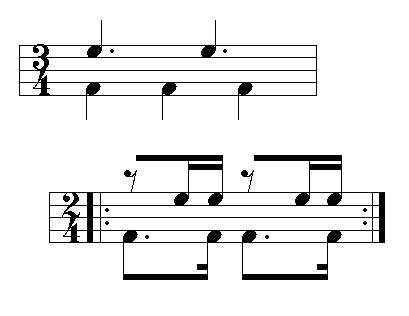Rhythm Exercises Brought to You By 3 Modern Jazz Heavyweights
 Kneebody came to town recently, and I had the wonderful opportunity to take a lesson with tenor saxophonist, bassoonist, pianist and composer Ben Wendel. In addition to playing with big names like Gerald Clayton, Jason Mraz, Taylor Eigsti, and Snoop Dogg, Wendel has often accompanied pianist Tigran Hamasyan and drummer, Ari Hoenig, two of the most rhythmically-innovative players on the scene.
Kneebody came to town recently, and I had the wonderful opportunity to take a lesson with tenor saxophonist, bassoonist, pianist and composer Ben Wendel. In addition to playing with big names like Gerald Clayton, Jason Mraz, Taylor Eigsti, and Snoop Dogg, Wendel has often accompanied pianist Tigran Hamasyan and drummer, Ari Hoenig, two of the most rhythmically-innovative players on the scene.
Most saxophonists concentrate the bulk of their practice regime on things like tone, scales, learning tunes, and running patterns.
Playing in odd-meters and working on rhythm tends to be seen as secondary to all this, despite the fact that odd-meter playing has become more and more prevalent over the past ten years.
Thus, as things stand, shedding time and rhythm can set you apart as a player and improviser. So when I sat down with Ben last week, I was itching to learn some of the rhythm exercises he’d picked up from his time with Tigran and Ari. Here they are.
1) Clapping rhythms while singing bebop heads
This one’s convenient because you can do it pretty much anywhere, no horn required (although a metronome is recommended). Sing a bebop head with some rhythmic complexity (e.g. Confirmation, Scrapple from the Apple, Moose the Mooch, etc.) and pick a repeating rhythm to clap. Try starting by just clapping offbeats, and see how long you can stay steady before you’re clapping on the beat. More complicated examples would be clapping syncopated 5- or 7-beat phrases.
2) Subdividing the metronome
This one is the most straightforward in terms of just sitting down with the metronome and clapping or playing along. Set the met at around 50-60 bpm and clap/sing/play once per beat, twice per beat, three times, four times, etc. up through 8 times per beat. Once you can do that comfortably, try moving randomly between subdivisions – going from 5 subdivisions per beat to 3 will feel very different than going from 3 to 5, etc.
3) Displacing a simple 4/4 beat
This one can also be done while singing a bebop head, or can be done on the horn or another instrument over a backing track. There are two ways to go about it:
- Clap (or play) 1 and 3, but start “1” on an offbeat.
- Do the same thing over an odd-meter tune (in this case you can start on the downbeat).
4) Turning triplets into the eighth note
This one really only functions in a group setting, and involves turning a 6/8 groove into a 4/4 groove. The triplets from the 6/8 groove become the 16ths in the new 4/4. It’s a nice method to change the underlying groove from a forward-pushing 6/8 feel to a heavier 4/4 feel without changing the pulse of the melody.
5) Feeling 3 and 4 against 5
This is the prerequisite to being comfortable with a lot of the groove-shifting stuff going on in modern jazz. The method is simple: for 3 against 5, clap every three beats with one hand (i.e. three eighth notes per clap) and hit every 5 eight notes with your other hand. For 4 against 5, the method is the same, except you’re hitting every 4 beats (you can think of them as eights or sixteenths) with one hand and hitting every 5 such beats with the other hand.
What all of these exercises will train you to do is to feel the big beat, and this is the key to having true rhythmic freedom in a group context.





